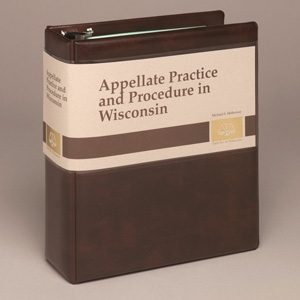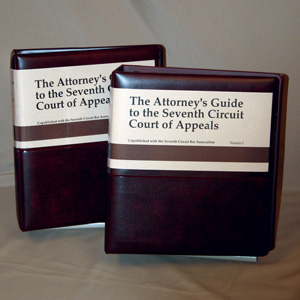
May 28, 2025 – Appellate judges, according to scholarly commentary, aren’t big fans of reply briefs, so when Circuit Judge Michael Y. Scudder, Jr., writing for a three-judge panel of the U.S. Court of Appeals for the Seventh Circuit, wondered about absent reply briefs, he was writing out of character.
The panel dedicated about half the opinion in United States v. Clark, 134 F.4th 480 (7th Cir. 2025), to “what we see as a troubling trend in our court: the missing reply brief.”
“All too often a party files a notice of appeal, pays the filing fee, and submits an opening brief, only to go radio silent when the reply brief comes due.”
Unnecessary, Except
Reply briefs aren’t necessary in federal and Wisconsin courts. “The appellant may file a brief in reply to the appellee’s brief,” says Federal Rule of Appellate Procedure 28(c). Likewise, Wis. Stat.
section 809.19(4) requires a response by the appellant, either a reply brief “or a statement that a reply brief will not be filed.”
 Jay D. Jerde, Mitchell Hamline 2006, is a legal writer for the State Bar of Wisconsin, Madison. He can be reached by
email or by phone at (608) 250-6126.
Jay D. Jerde, Mitchell Hamline 2006, is a legal writer for the State Bar of Wisconsin, Madison. He can be reached by
email or by phone at (608) 250-6126.
The reply brief’s purpose “is to respond to any arguments raised in the respondent’s brief that were not adequately addressed in the appellant’s brief-in-chief,” advises Michael S. Heffernan in
Appellate Practice and Procedure in Wisconsin, section 11.23 (9th ed. 2022).
The Seventh Circuit sees it the same way according to the comparable treatise, Stephen E. Arthur et al.,
The Attorney’s Guide to the Seventh Circuit Court of Appeals, section 12.41 (8th ed., 2024).
Critical commentary says not to file one if it’s only going to regurgitate what one wrote in the appellant brief. The failure of lawyers to limit reply briefs to their purpose is what makes judges skeptical.
“‘Reply briefs are not the favorite children of appellate judges.’ But that’s mostly because they’re often done so poorly that they’re a waste of time, money and paper,” wrote Gerald Lebovits in the
New York State Bar Journal.[1]
“[M]ost appellate judges dislike the last word syndrome, especially in the form of reply briefs,” wrote Jason Vail in the
Journal of Appellate Practice and Procedure.[2]
“This dislike springs in part from the fact the judges have lots to read – but their reading time is rationed, and they don’t want to waste it on the unnecessary.”
If, as is alleged, lawyers like to have the last word, and their briefs show it, they may draw judicial ire.
“A reply brief is not a forum for the appellant to merely restate arguments already made,” according to
Appellate Practice and Procedure in Wisconsin. “A reply brief should not be filed for the sole purpose of getting in the last word and restating the appellant’s strongest arguments.”
Those instances may be atypical. “[R]are is the case where it is acceptable, much less wise, for an appellant to merely file a letter in lieu of a reply brief, indicating she will stand on the arguments presented in her initial brief,” wrote the panel in
Cottonwood Financial, LTD v. Estes, 2010 WI App 75 (vacated and remanded on other grounds).
In that case, the respondent’s failure to address mandatory law also absent from the appellant’s brief saved the appellant. Without a reply brief to address issues raised in the respondent’s brief, the appellant concedes them.
Defeat resulted in
Apple Hill Farms Development, LLP v. Price, 2012 WI App 69, when the appellant presented only foreign law and the respondent’s brief “relied on Wisconsin authority.”
Absent Briefs
A federal jury found Michael Clark guilty of possessing a controlled substance that police obtained from his hotel room in Superior. His conviction survived appeal to the Seventh Circuit.
Clark believed the police investigator who requested the search warrant failed to include information that would challenge the credibility of the police’s confidential informant.
On remand, Clark moved to suppress the evidence. A federal magistrate, however, found credible the police investigator’s testimony that the officer “did not purposely or recklessly omit” the informant information. U.S. District Court for the Western District of Wisconsin Judge James D. Peterson adopted the magistrate’s recommendation.
Clark is in a hard position on appeal. Reversal comes with only clear error, a tough standard to meet. He failed in his appeal. The analysis took only a page.
The opening brief Clark’s attorney submitted presented the issue, the panel explained in its decision. The response, however, “rais[ed] a new argument defending the district court’s judgment” not anticipated in Clark’s brief – and then reminded the reviewing panel that a deferential standard applied on review.
“Clark then filed no reply, leaving us with the impression that he had given up on the appeal or somehow sought to salvage his position during oral argument. Either way, we were left wondering,” Scudder wrote for the panel that included Circuit Judges David F. Hamilton and Michael B. Brennan.
It happened again in
Moderson v. City of Neenah, No. 23-2843 (May 9, 2025). Another Seventh Circuit panel noted that the plaintiffs’ lack of a reply brief caused the appellants to “forgo[] the opportunity to respond to the specific
Terry arguments detailed in Defendants’ response brief.” The plaintiffs lost.
‘Help[ing] the Judges’
If an appellant’s brief “anticipates and addresses all points” that come up in the respondent’s brief, or if the respondent concedes an error, perhaps the reply brief is unnecessary, Scudder wrote.
A reply brief can help the judges, the Seventh Circuit panel said. “[A] tailored, efficient, and well-presented reply brief” serves a “significant role.”
“A reply brief is a party’s opportunity to respond to material points pressed by an adversary and to put the reply within the framework (legal or factual) of the opening brief.”
Some judges, Lebovits wrote, might look to the reply brief first. “By reading in reverse, retro-reading judges immediately assess the heart of the controversy and avoid considering irrelevant, academic, conceded, or unopposed issues.”
In a case without oral arguments – not unusual in a court of appeals – the reply brief may be critical, Lebovits added.
‘Hardest of All Briefs’
“I’ve never not filed a reply brief,” said Attorney Joe Bugni, who immediately apologized for his double negative. “I always file.”
Bugni of Hurley Burish, S.C. in Madison focuses on trial and appellate litigation in both civil and criminal cases in Wisconsin and federal courts. Most of his representative appeals appeared in the Seventh Circuit Court of Appeals involving criminal matters.
He started his career spending five years as a law clerk in federal courts, including two years at the Seventh Circuit Court of Appeals.
“I’ve read a lot of briefs,” Bugni said.
“I think that on the civil side, everyone [files a reply brief] because everybody’s billing,” Bugni said. You know, like, ‘yeah, I want to make sure I get this.’ And it’s more of a toss-up … in the civil context.”
On the criminal side in general, it could come from the volume of cases – and the uphill struggle of a criminal appeal. “You lose so often that you’re just kind of going through the motions,” Bugni said. “They’ve lost the verve to make their case.”
Writing reply briefs creates difficulties, which may be why the results lead to their bad reputation.
“You don’t want to have it so that it’s like ‘They’re wrong! They’re wrong! They’re wrong!’” Bugni said – and the judge forgets what the argument was about. Bugni has found a structure that helps him break that mold, but it’s tough.
“Writing a reply brief in my view is the hardest of all the briefs, and it’s always vexed me.”
Two Appellate Practice Guides from the State Bar of Wisconsin
Appellate Practice and Procedure in Wisconsin

If you plan on appealing a case to either the Wisconsin Court of Appeals or the Wisconsin Supreme Court, this is the standard reference on appellate practice in both. You’ll find Appellate Practice and Procedure in Wisconsin’s 28 chapters provide basic information on appellate procedures, as well as sophisticated commentary on expedited appeals, briefing, oral argument, one-judge appeals, and other important topics.
Several appendices provide additional resources – including:
A “Standards of Appellate Review” outline, prepared by the Hon. Thomas Hruz of the Wisconsin Court of Appeals, District III and by attorney Nathan Petrashek, who works for the Wisconsin Court of Appeals, District II
Numerous appellate court forms, prepared by the Clerk of the Wisconsin Supreme Court and Court of Appeals
The full text of the Wisconsin Rules of Appellate Procedure
Both the print and Books UnBound versions include a complete set of fillable, unannotated forms via download.
Find out more at
WisBar Marketplace.
Attorney’s Guide to the Seventh Circuit Court of Appeals

If you were to attempt dashing off an appeal to the Seventh Circuit, your failure to properly observe the rules could result in rejection of your brief – or even a fine. Not to mention the time wasted on rewriting the brief and the loss of confidence your client could experience.
Luckily, you can avoid these results with
The Attorney’s Guide to the Seventh Circuit Court of Appeals. It’ll become your road map to delivering a successful appeal.
You’ll proceed with confidence as the Guide walks you through the process of appealing to the Seventh Circuit. You’ll always know what to do next with the step-by-step guidance of experienced practitioners. You’ll also be forewarned of known pitfalls – especially useful if this is an area of law in which you haven’t practiced before or in some time.
Helpful examples of how your brief and related papers should be formatted are just the start with this book. You’ll also save research time with the Guide’s index and topic tabs. And you’ll avoid blind alleys with useful charts and lists summarizing courses of action, along with appendices like the complete Federal Rules of Appellate Procedure and the corresponding Seventh Circuit rules.
Find out more at
WisBar Marketplace.
Endnotes
[1] Department:
The Legal Writer 82-Jun N.Y. St. B.J. 64 (June 2010).
[2]
The Pitfalls of Replies, 2 J. App. Prac. & Process 213 (Winter 2000).
